It’s difficult to know where to begin the RK2020 review. The moral high ground regarding cloned hardware is probably not it. It’d be easy to dismiss the RK2020 as a lazy copycat device, attempting to cash in on the good work of HardKernel. Whilst it’s true that the RK2020 wouldn’t exist without the OGA, this hobby usually treads a legal grey area one way or another. There is no proprietary hardware inside the Odroid-Go Advance, so whilst it might be cheeky to build 100% compatible hardware, given the success of the OGA it’s hardly a surprise to see.
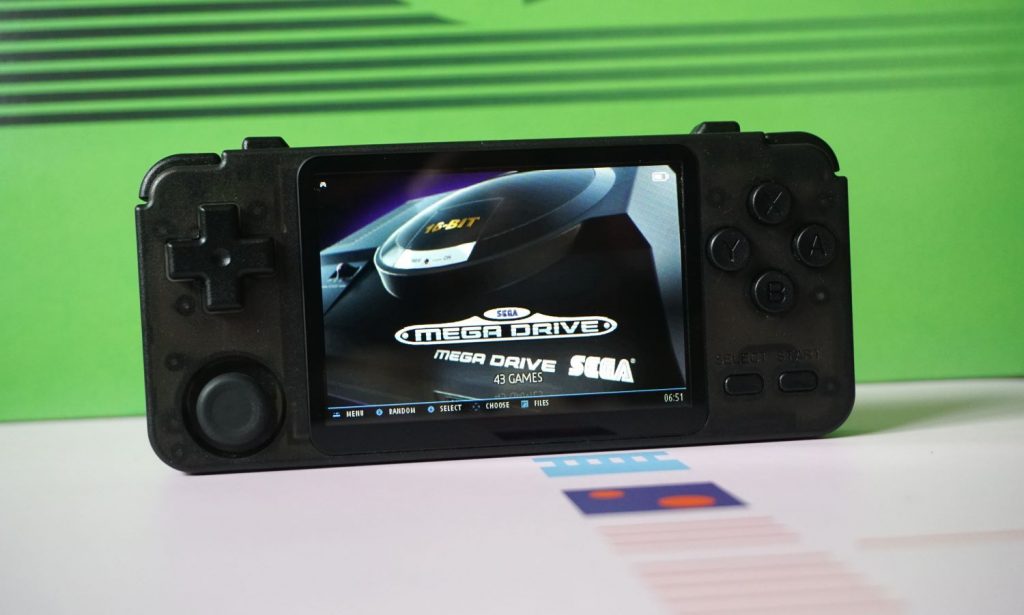
Having said that, it is frustrating that some Chinese manufacturers are so averse to innovation. When the RK2020 was in early development, and knowing that the hardware would remain largely the same as the OGA, I suggested some ways to improve on the original design. A higher resolution screen, dual analog sticks, built in WiFi, HDMI output, for example. Even just using widely available off the shelf d-pad and buttons for colour customisation would have been nice.
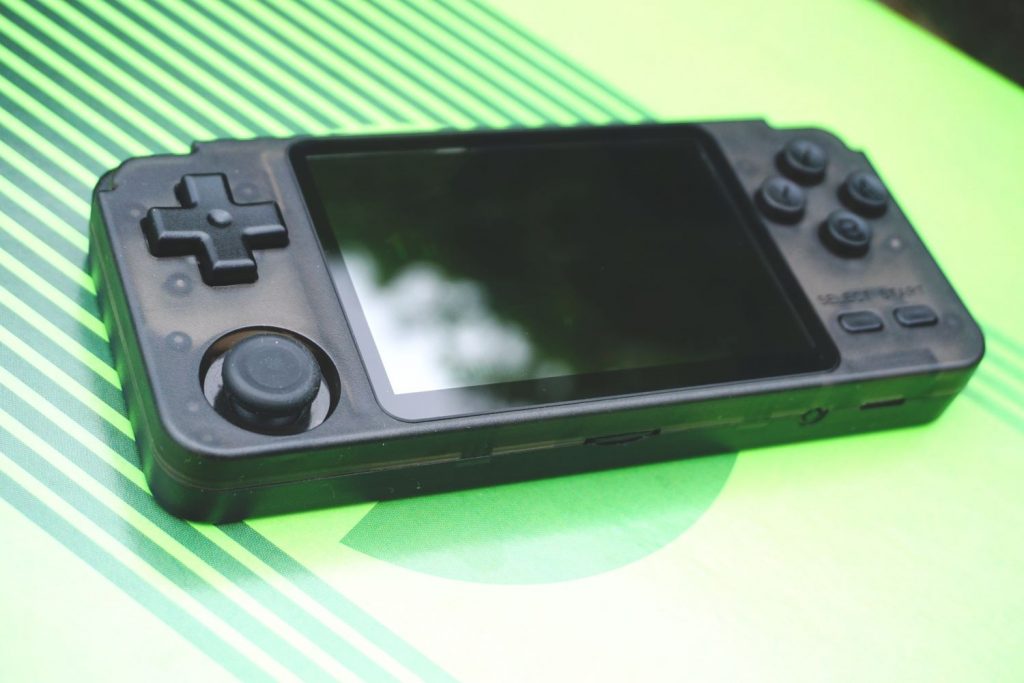
But whilst we got two extra shoulder buttons, the rest remains basically the same as the OGA internally. There’s a reason for that, and that’s the software. It was designed in such a way that any OS for the OGA could be used on the RK2020. Why? Because software developers are expensive, I suppose.
The factory even went as far as cloning the image from the 16MB SPI Flash module on the OGA. If there was a line to cross, you could argue that they crossed it there.
With all that said, one glaring difference between the RK2020 and the OGA is that little row of 6 buttons underneath the LCD. The RK2020 doesn’t have them, instead relying on the more standard configuration of a Start and Select button. More on that later.
BUILD QUALITY AND BUTTONS
There’s nothing wrong with the way the RK2020 feels, but it won’t win any awards for its design or build quality. It’s a solid enough machine, on a par with or slightly better than the OGA whilst also being a bit smaller. Whilst the plastic feels thinner, the overall aesthetics and design choices are slightly better than the Odroid Go Advance. It doesn’t feel as well made as the PocketGo v2 or the RG350, but there’s nothing really to complain about.

The buttons rattle, but the concave ABXY buttons are very nice. The d-pad is responsive, and I prefer its rounded edges to the rather sharp d-pad on the OGA. In my opinion the d-pad sits too high out of the shell, it could do with being recessed a millimetre or 2 more. Personal preference I suppose. The shoulder buttons are clicky and wobbly but are well placed and easy to press. The raised R2 and L2 make it very easy to discern them from L1 and R1.

The analogue stick is the same as the one used in the OGA (surprise, surprise!), but it ships with a rubber cover which makes it nicer to use. The cover offers a slightly concave and nicely grippy surface for your thumb to sit in.
The power button at the top is in about the same position as the one on the OGA, and sits flush to the case. You won’t be hitting it by accident. On the bottom edge there’s a reset button, which currently does nothing and I couldn’t map it to anything either. The charge port is USB-C just like the OGA v1.1 and there’s a USB-A port for use with WiFi dongles, which does work.
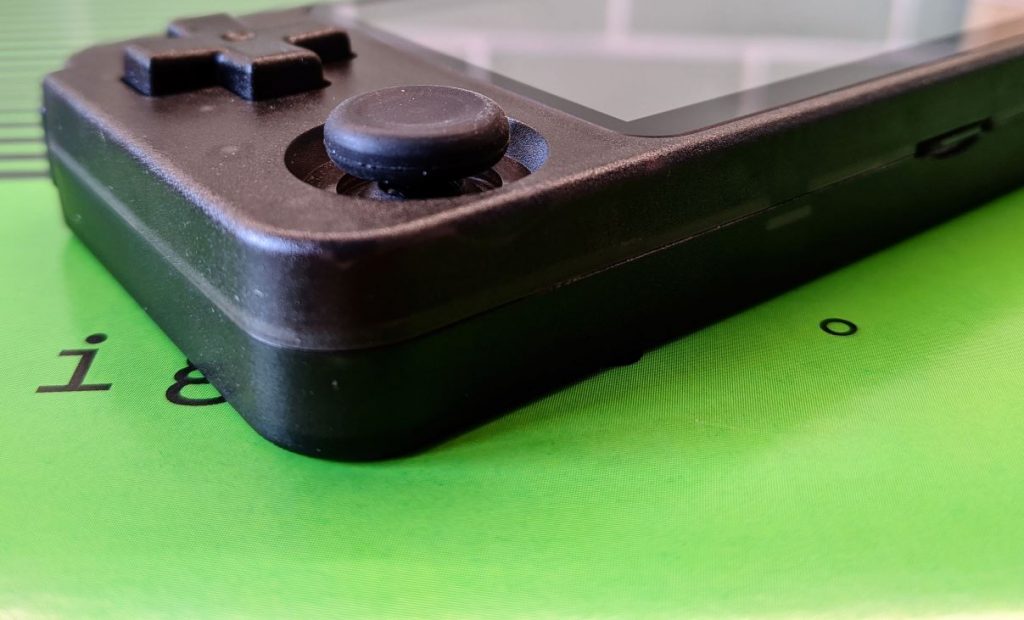
The speaker is in the bottom right and there’s a small slit to allow the sound to travel. Nothing to shout about, but it works and I don’t find myself accidentally covering it with my hands. The headphone socket is labelled as TV, but it’s not. It does work fine with a pair of headphones plugged in though.
There’s no volume control on the RK2020, instead relying on holding L2 & ↑↓ to change the volume. You can also change it using Select & ↑↓ in game. These appear to be two seperate volume controls, one for the system and the latter for RetroArch (I think?). A confusing UX decision which is probably also present on the OGA.
LCD
The LCD is the same resolution as the one in the OGA and has narrower connector to the mainboard. It’s a 3.5 inch 480×320 display, very colourful and crisp and with good viewing angles. It runs at 60hz and you won’t notice any screen tearing or ghosting of any kind. It’s hard to see outside in bright daylight, but inside it’s gorgeous.
Although I’ve been told it’s the same LCD by the seller, some colour temperature comparison shots between the RK2020 and OGA imply it may be different. They both function with the same driver however, and look pretty much the same overall.
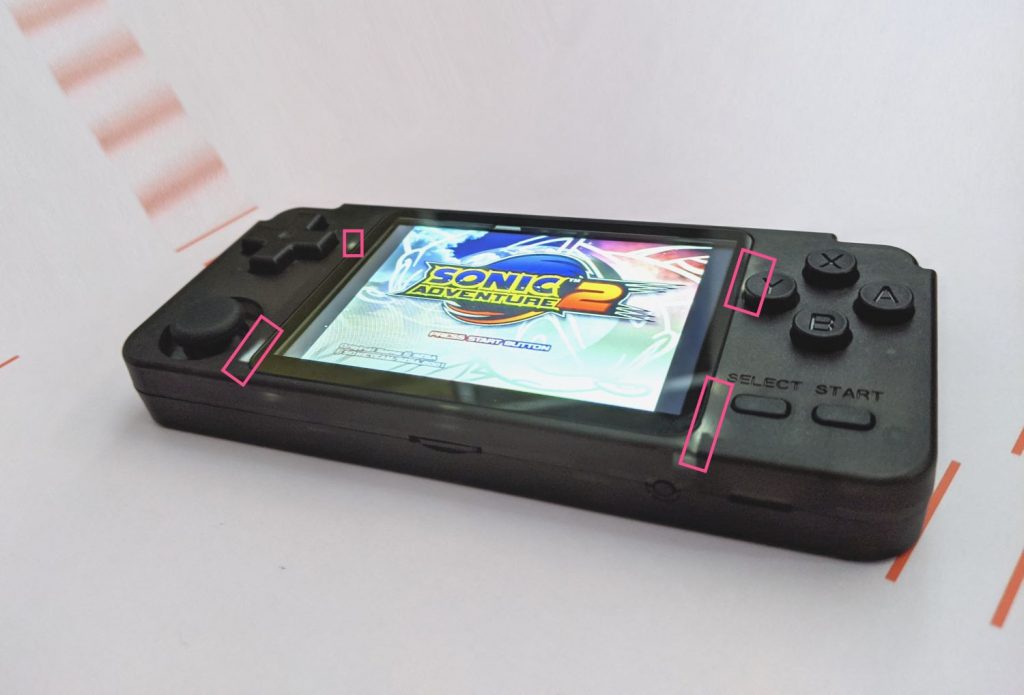
There is some light bleed from around the edges of the screen bezel. It’s not too distracting, but it’s there.
If it bothers you, you can probably mask it off with electrical tape from the inside of the shell.
The screen lens is made of glass as far as I can tell.
SOFTWARE
The website states that the unit does not ship with an OS, but mine did. Perhaps it’s because I was sent a unit for review, but my RK2020 came with an unmodified EmuELEC 3.5 pre-installed. I have since flashed the latest 3.6 image and am using that instead for my testing. It is safe to assume that any current OGA image will run on the RK2020, so take your pick. This might not always be the case though. There are rumours that future builds will lock out cloned devices, so there’s that. The Retro Arena (TheRA) is pictured below.

The lack of buttons on the RK2020 starts to become an issue when you dig a little deeper. Whilst it’s potentially possible to edit config files to re-map global hotkeys etc, out of the box both EmuELEC and TheRA have problems. In PSP for example, the Select button can’t be used in game, because Select quits the emulator. You can open the emulator settings by hitting Start, but even re-mapping the controls in the settings menu causes the emulator to quit once you try to map Select. And once you’ve correctly mapped Start, you can’t enter the emulator settings again using that button. It’s a bit of a mess.
In TheRA, I simpy can’t find a way to get to the emulator settings menus to change cores, frameskip, shaders etc. Some emulators have their in-game settings available through some combination of buttons, others do not. In Dreamcast and PSP the Select button quits the emulator.
The RK2020 needs a customised OS, which brings us back to the issue of there being no software developers on-board. Although Shanti (EmuELEC dev) has apparently been sent some RK2020 units, the team have stated that they won’t develop for the RK2020. The retailer has told me that units are going out to TheRA and Batocera devs too, but there are no promises from anyone. It’s frustrating that this wasn’t considered before the device was released, and will likely result in unhappy customers.

If the RK2020 factory had cloned all six buttons from the OGA, it would be less of a problem now. It is usable in its current state save for some issues in certain OS and emulator combinations. I’m willing to wait it out in the hope that a developer takes a shine to this machine, but I do understand that the OGA devs could be quite pissed off right now and unwilling to step in.
PERFORMANCE
Emulator performance for the RK2020 is theoretically the same as the OGA, which should come as no surprise. I say theoretically, apparently some Chinese users are experiencing thermal throttling after prolonged play times. I can’t say I’ve experienced this, although the device does get warm once you’ve been playing a while.
The machine is capable of everything up to and including N64, PSP, Dreamcast, CPS3 and even Saturn. Don’t expect the entire library of games for any console to run flawlessly. In fact for those newer or harder to emulate systems compatibility can be quite low.

In EmuELEC some emulators can benefit from being tweaked, for example N64 performs way better when the MUPEN64PLUS_LIBRETRO core is set. Many emulators look nicer once smoothing has been enabled, due to the odd screen resolution. PSP and GBA look amazing on this device with integer scaling selected, though. The 480×320 resolution panel works perfectly with the 480×272 and 240×160 resolutions of those devices.
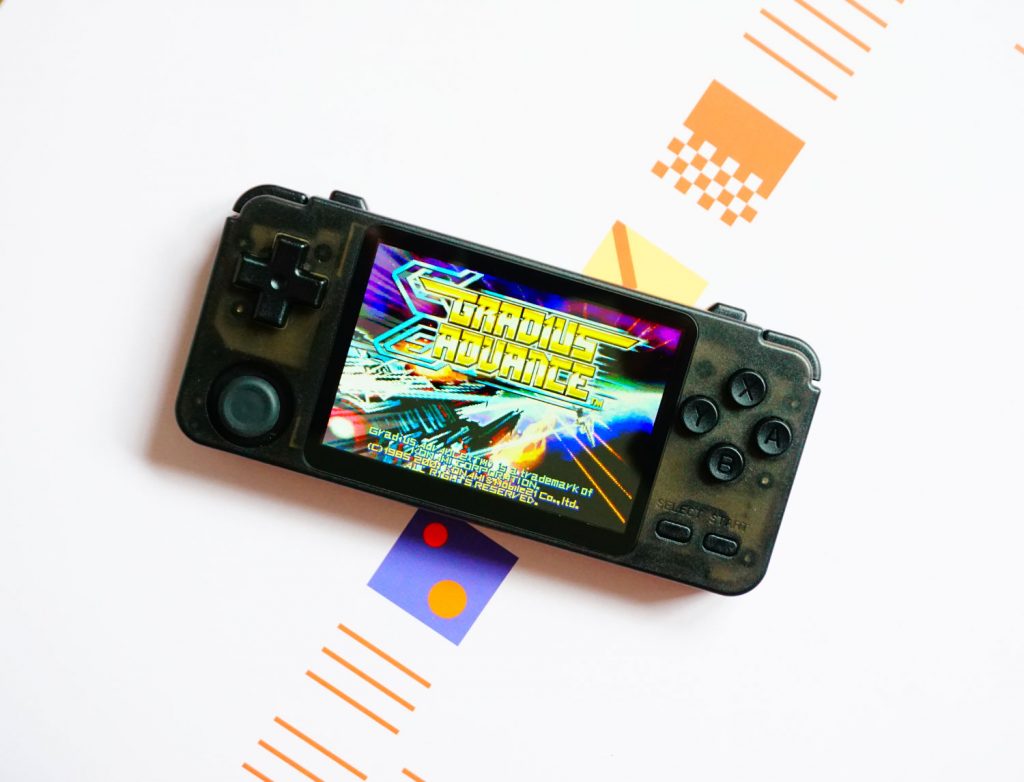
As mentioned previously, I can’t get to the core settings in TheRA. I assume this is because the F1 key does not exist in the RK2020. After mapping my buttons in TheRA, I logged in via SSH and had a look at the mappings.
<input name="a" type="button" id="1" value="1" />
<input name="b" type="button" id="0" value="1" />
<input name="down" type="button" id="7" value="1" />
<input name="hotkeyenable" type="button" id="4" value="1" />
<input name="left" type="button" id="8" value="1" />
<input name="leftanalogdown" type="axis" id="1" value="1" />
<input name="leftanalogleft" type="axis" id="0" value="-1" />
<input name="leftanalogright" type="axis" id="0" value="1" />
<input name="leftanalogup" type="axis" id="1" value="-1" />
<input name="leftshoulder" type="button" id="12" value="1" />
<input name="lefttrigger" type="button" id="4" value="1" />
<input name="right" type="button" id="9" value="1" />
<input name="rightshoulder" type="button" id="13" value="1" />
<input name="righttrigger" type="button" id="5" value="1" />
<input name="select" type="button" id="10" value="1" />
<input name="start" type="button" id="15" value="1" />
<input name="up" type="button" id="6" value="1" />
<input name="x" type="button" id="2" value="1" />
<input name="y" type="button" id="3" value="1" />Judging by this, the two missing buttons are 11 and 14. On the OGA button 10 is F1, but here it is Select. I’m not really sure what to make of that to be honest.
There are plenty of videos on YouTube showing off various games, so I won’t list them all here. If there’s a specific game you want me to test just let me know.
TRANSFERRING ROMS
If you have a Linux machine or VM, you’re good to go. Just stick the SD card in and transfer in to the ROMs directory. If you’re a Windows user, you have to jump through some hoops. The easiest way is to use a WiFi adaptor, make a note of your device IP address and login through an explorer window with \\<ip_address>. You can then drag and drop your ROMs into the corresponding folders.

Another method would be to use a Windows application that allows writing to ext4 partitions. Apparently Paragon have one, but many people have complained that it corrupts SD cards. Better to go the WiFi dongle or Linux VM route probably.
CHARGING
If you switch the device off and plug it in, it will boot up and show that it’s charging. However, the screen stays on. If you plug in the RK2020 and then shutdown, all lights go out and it’s not possible to tell if the unit is charging. I suspect it is not, or at least charging incredibly slowly. Thankfully in newer OS builds you can hit the power button once to put the RK2020 to sleep. The device continues to charge whilst sleeping.
Currently the best way to charge the RK2020 is switched on, asleep and with the WiFi dongle removed as it drains power fast. It’s best to remove the dongle entirely when you’re not using it, otherwise battery life suffers massively.
According to Chinese forums, this device charges at 0.6a, compared to the 1.4a of the OGA. I don’t know why this would be, unless they’re using a different charge controller.

SHOULD YOU BUY THE RK2020?
This is a tough question to answer. If you feel strongly about cloned devices then the answer is probably no. If you don’t care about cloned devices, the answer is maybe.
On one hand, the RK2020 has a similar if not better build quality than the OGA. It comes pre-assembled, is roughly the same price or a bit more expensive depending on where you live, and has four proper shoulder buttons. It’s a little bit smaller than the OGA, and is very comfortable to play. Oh yeah, and it’s in stock. In some ways it’s the most attractive proposition for a reasonably priced, portable handheld capable of PSP, Dreamcast, N64 etcetera.
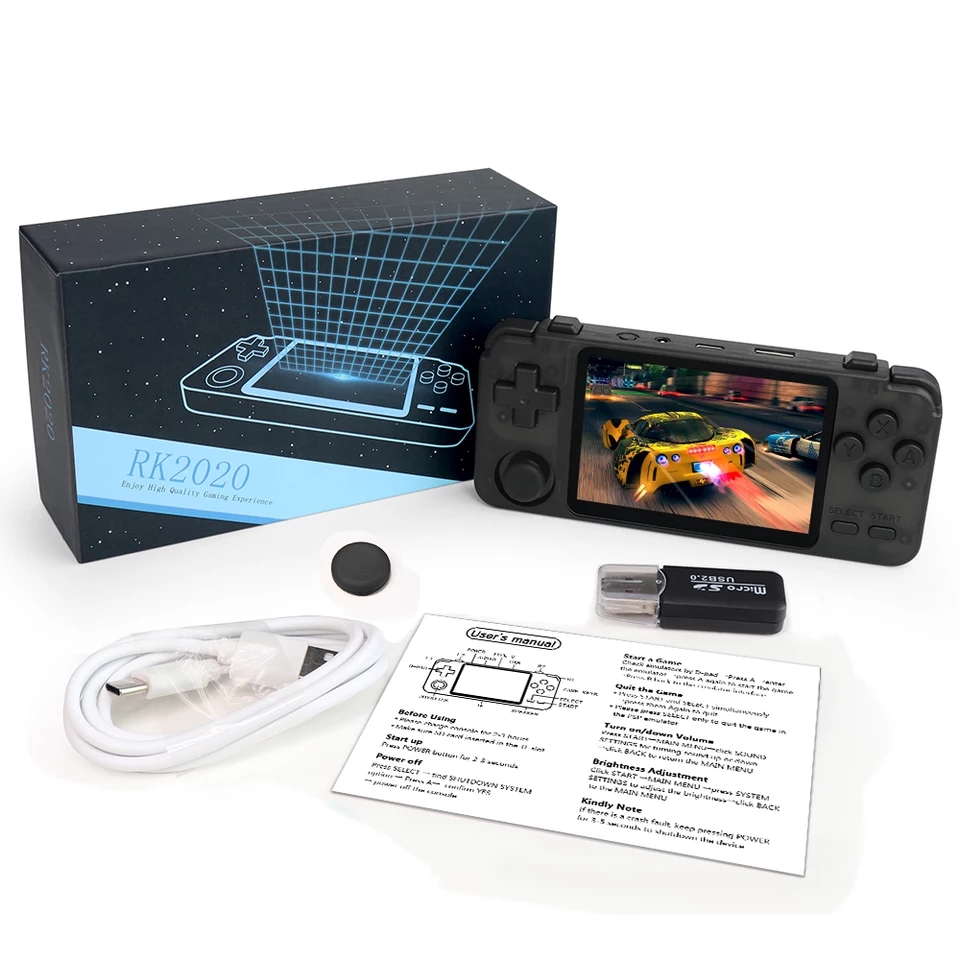
On the other hand, the factory dropped a bollock by not including all six buttons from the OGA. Doing so has meant that a lot of the work that went in to cloning the OGA has been lost due to functionality issues arising from the missing buttons. As mentioned previously, re-mapping global hotkeys may be possible (I don’t know), but even that somewhat defeats the point. Now the people behind this machine are looking for developers to fork the OS and properly support the RK2020. Doh.
It boggles my mind that the factory thought all those extra buttons didn’t do anything or weren’t important enough to include. It has detracted from an otherwise amazing little machine. I do expect that someone will probably fix this, if not one of the official devs then someone else. Currently though it’s limited in its potential, which is a shame.
If you’re after some sweet Dreamcast action and don’t want or can’t get hold of an OGA, you will still have a lot of fun with this handheld. It’s amazing to see relatively cheap handhelds finally being capable of emulating newer systems, god knows we’ve waited long enough! I’m having an absolute blast playing through F-Zero X on the N64 for the hundredth time.
If you’re willing to take a gamble on the RK2020, or feel like having a crack at ironing out the software issues then they’re available to buy right now from Amazon, AliExpress and rkconsole.com.
This RK2020 was kindly donated on the understanding that I would review it as accurately and fairly as I could. If you liked my RK2020 review, please consider sharing it!

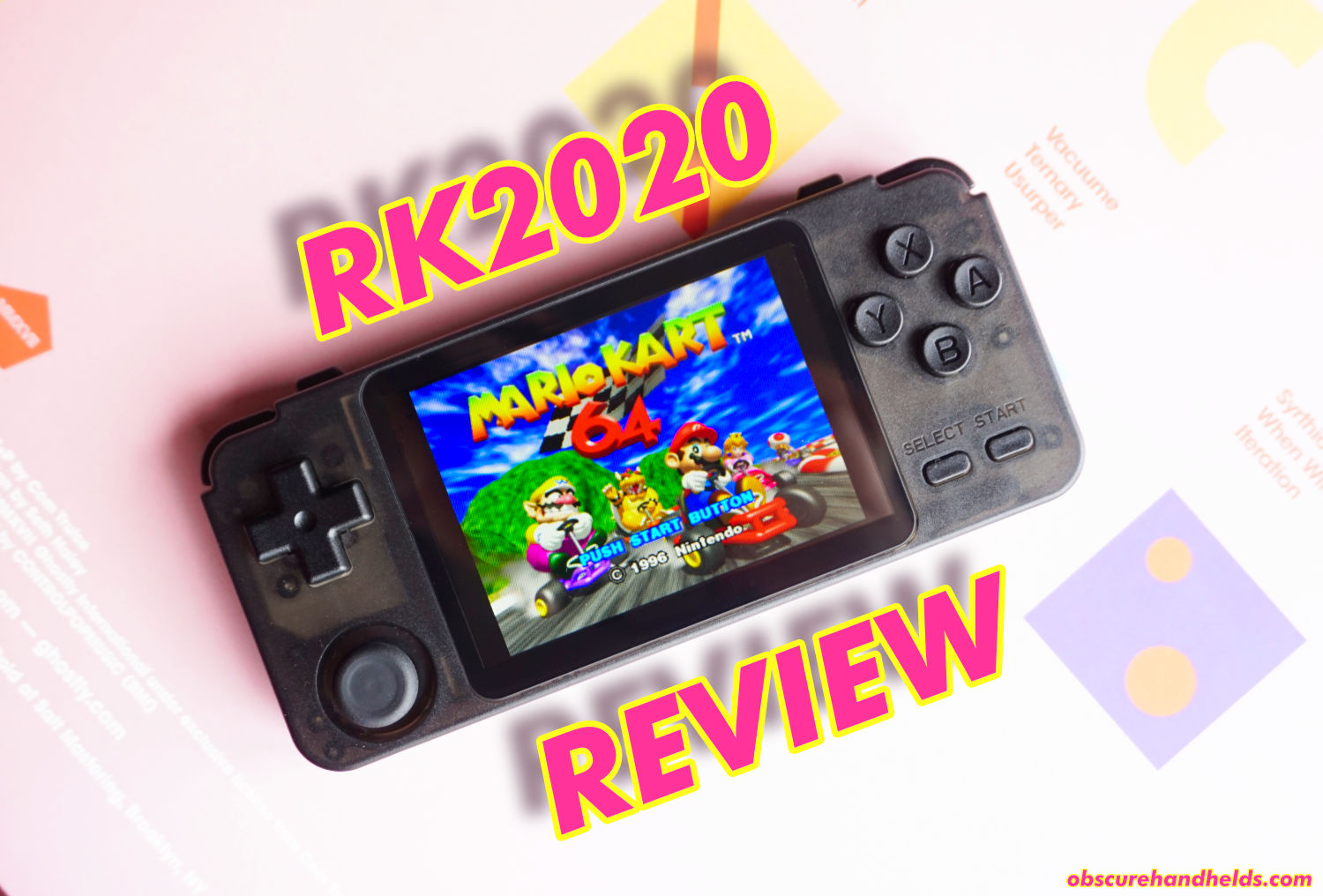
Anyone know how to switch the N64 emulators?
Hello I need to add game in rk2020 emuelec but don’t know how due I don’t hav laptop is there a way do on phone please help
I was given this device by a friend today who ordered it but had no need for it. I understand this is a cloned version of an open source device, but lacks the same set of function keys. Does this mean we are simply unable to access standard features in game like quicksaving and settings adjustment? It seems the only thing you are able to do from in game is quit out with start+select.
My friend purchased his and it seems to have shipped with emuelec 3.5 but I dont know very much about this stuff so I’m not sure the significance of that other than its open source application on a commercial device.
If you are located in mainland China, choose RK2020. Otherwise, choose OGA.
480×320 is a bad resolution for most systems that were 320×240, it just doesn’t scale well and ends up either looking blurry or pixelated. It would be better if it was either 320×240 or 640×480.
Not sure if you guys have seen this:
https://a.aliexpress.com/_d6vUGTe
Love the design and size, but $94 is too much.
Hey man, thanks for your review – great site. I just got one of these through the post, have tried to use a 64gb image that works for the odroid go advance (arcade punks) to work on this, but no joy.
What’s the best images to use?
I’ve tried EmuELEC and TheRA, EmuELEC works well enough. In TheRA I can’t access the emulator settings. What happens when you try to boot arcade punks?
Thanks, it just does nothing at all won’t even turn on unless I swap back to the EmuELEC card that it came with.
You must be doing something wrong. Use Balenaetcher to write the SD card image.
I did try that, seems to copy to the sd card okay but when verifying comes up with an error. I tried it anyway, but still the same thing. For reference, I’m using a decent Sandisk sd card.
If it’s not verifying then there’s either something wrong with the image you’re using or your SD card is faulty.
I personally think the RK has a good future ahead! In fact I will go out on a limb and postulate that HK worked with RK to produce the RK2020.
In my experience the OGA build quality is quite lacking. Having to assemble the OGA does not work for most people. The proposition of getting a replacement part for a failed OGA build taking 12-16 weeks from Korea, or paying $30 for faster shipping, makes the already assembled RK2020 quite appealing!
I honestly think these companies make near perfect machines on purpose to make you buy the next revision. They could have easily added six vertical buttons on the bottom right similar to the 4 on the Q400 not doing so just seems lazy. This does usher in the next wave (gen) of these kinda consoles so I’m excited. I think if OGA wasn’t so hard to come by this wouldn’t even be a thing. They saw a gap in the market and responded quickly cut corners to get the product out. I doubt they care about the long term usability and future software compatibility.
Seems to be a bit of a waste. The updated pocket has wifi built in and also (afterthought) shoulder buttons. Plus you don’t need to jump through hoops to use the buttons that should have been included on this one.
If there’s another clone that does a better job of no light bleed and good build quality with all the functionality of the OGAv2 I say go for it.
At this point though (and considering Hardkernal are not the pricey alternative) there’s zero reason not to support the company that actually engages with their customers.
So wait is this thing 320×480 or 480×320? I keep seeing conflicting information and I can’t tell which one it is. 320×480 makes sense because you can double the vertical height of a 320×240 game to take up the entire screen, but 480×320 also makes sense because it would allow a 2x integer scale of GBA games
it’s 480×320 when placed in landscape orientation. i think they keep calling it 320×480 because it’s supposed to be a portrait mode screen.
I don’t mind clone devices at all if they do a good job!!! Especially for such friendly prices!!
BUT, I do agree on all the necessary improvements…
In that case, I’d be happy to pay more for a version that:
– Has all the buttons of the OGA
– Has at least 480 pixels height (and the software supports it natively)
– Buttons dont wobble / rattle
– Doesn’t throttle or get warm
– Light doesn’t bleed
Did I forget something? It looks like we’re really close to having REALLY WORTH BUYING devices!!
Excellent review!
I have a question about the software that the RK2020 is using. If is a clone of the ODROID, can HardKernel make a move where the future updates can only be used on the ODROID and “ban” the RK2020? Or future updates will work on the RK2020 too forever?
Yeah, I think I mentioned under the software section that there have been rumours that future updates will lock out cloned consoles. I don’t know if that will actually happen, or how they’d do it. It’d be a bit rash, but who knows.
I ended up jumping on this when it was announced and waiting for my order to get here. Sadly, I think I should have waited since I own an RG350 and that has been the perfect handheld for me. This one seems like it has potential, but it needs more time in the oven. Whether the devs or the hardware maker are going to step up at this point is anyone’s guess.